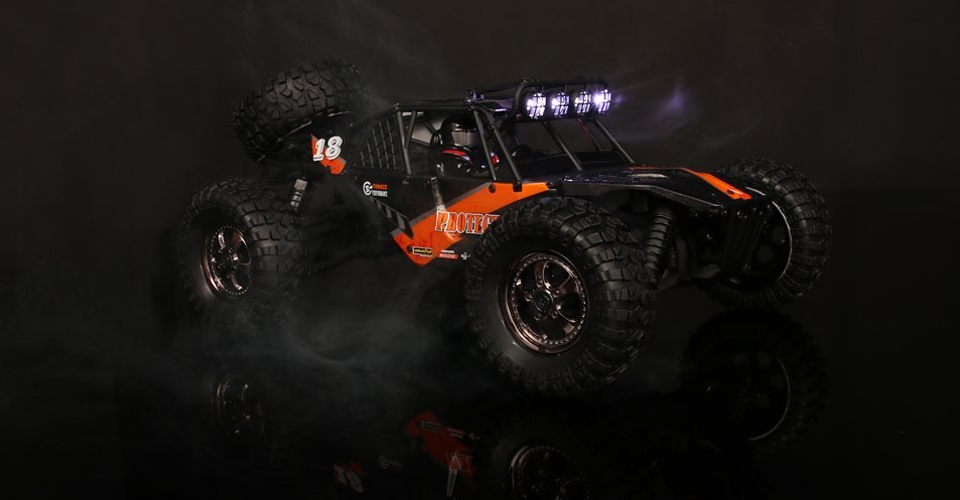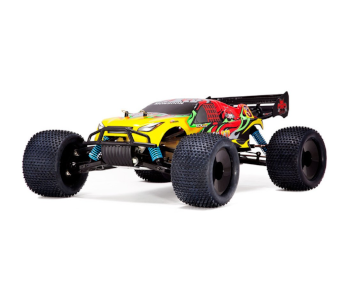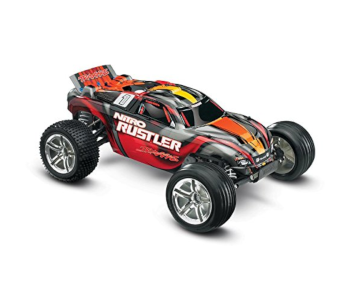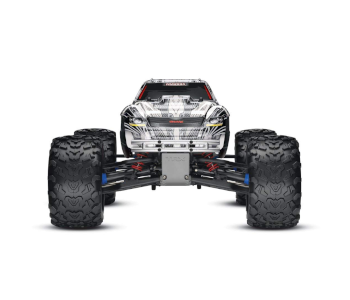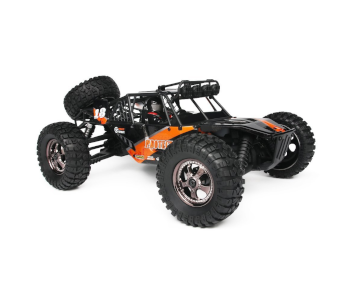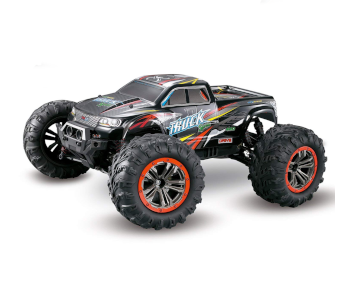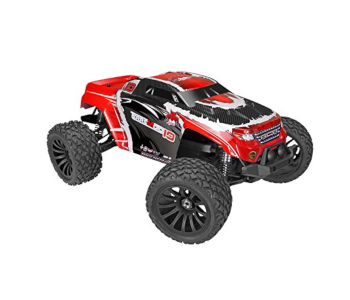Nitro vs Electric RC Cars – Which one is better?
The debate rages on with nitro VS electric RC cars, trucks, buggies, and truggies. It’s not a simple case of which is better—it’s more to do with personal preference. These models are poles apart in several ways, and each type has its loyal following. This guide explains those differences with an easy-to-understand breakdown. That includes the advantages, attractions, and any negatives.
I also include 6 short reviews, 3 for electric cars and 3 for nitro. These are all current favorites that illustrate the points raised here. I order each review section as Best Budget, Best Value, and the Top Pick. This way you get to see what each price category has to offer.
About My ‘Nitro Vs. Electric RC Cars’ Guide
Each model has a separate section to avoid bouncing from one type to the other. The format for both nitro and electric models is the same so that the comparisons are clear, i.e.
- Model design
- Price tags and running costs
- Performance & handling
- Running time
- Maintenance
- Repairs & upgrades
- Durability
The Pros and Cons of a Nitro RC Car
The next section looks at nitro-powered RC cars using the points above, followed by 3 mini-reviews. Feel free to skip to the reviews if you already know the differences between these models.
Nitro RC car designs
Nitro-powered RC cars have more complex designs than their electric counterparts. Enthusiasts love this complexity, though, as it gives them access to the vehicles inner workings. Tuning engines, modifying performance, and adapting sounds are all part of the thrill. The relationship between owners and their gas-powered cars is an intimate one.
Design cons: You can’t run a nitro car safely indoors on bad weather days. They’re too big, too powerful, too noisy, emit toxic fumes, and carry highly flammable fuel.
Price and running costs of nitro RC cars
Nitro RC models generally cost more than electric vehicles. It’s not only about purchase price either. You need to refuel the tank regularly, and then there are maintenance costs. Most nitro fans like to upgrade their vehicles as well. Replacing stock parts can add a significant amount to the initial price. Some models need starter packs, batteries, and chargers as well.
Performance and handling
The versatile performance and handling of nitro RC cars is their main attraction. What you see is not what you’re stuck with. Being able to customize and fine-tune these models is half the fun. Users can tweak and upgrade just about everything on the car if they want to. They’re fast too, most with incredible acceleration and top speeds from 35 to 60+ mph.
Performance and handling cons: Nitro cars need lots of attention. Owners must always maintain their engines and make sure that all moving parts are working and secure.
Nitro car running times
How long these cars run for depends on a few factors. One is the size of the fuel tank that typically ranges from 75cc to 125cc. The latter size should give 25+ minutes per tank of gas. Faster, more aggressive driving results in shorter running times. Engine tuning can also have an impact on play time. A well-tuned engine is going to give you a longer run than one that’s out of sync.
You must wait for the battery to recharge when an electric car runs out of power. Either that or swap batteries. That can be easy or fiddly depending on the model. Nitro cars only need a fuel top up.
Maintaining the vehicle
Nitro cars need regular maintenance and repairs, and that takes knowledge and skill. Failure to maintain and repair weak or damaged parts will bring any model to its sudden death. The cleaner the car, the longer it lasts and the better it runs. Regular maintenance involves things like cleaning air and fuel filters and checking the glow plug, etc. Rotating the tires is another job for the checklist.
Screws and other parts can come loose and thus need routine checks. Others are the differentials, shocks, drive pulleys, drive belts, ball bearings, and more besides.
Repairs and upgrades
Things occasionally break, either through wear and tear or from accidents. Problems with nitro RC cars are quite easy to diagnose despite the complex designs. After all, there’s only so much that can go wrong. Repairing a damaged part, though, is something else. Sometimes the broken bit is beyond repair and needs replacing. That can be cheap or costly depending on the piece.
Stock parts are usually weaker than custom upgrades. All nitro RC car owners should learn how to fix or replace broken components. Most people swap the cheaper stock parts with higher-quality ones. The choice of upgradable parts depends on the type of vehicle and user expectations.
Nitro car durability
Durability between nitro RC cars differs between model types and brands. It’s no different to electric RC cars in that regard. However, the resilience and crash-resistance of a nitro model are not only about build and materials. It’s also about maintenance. Poor maintenance can result in a vehicle that’s more prone to breakage. Note that most RC nitro models are not waterproof. Many electric cars are.
All manufacturer’s sales pages promote models as being highly-durable, especially the chassis. The only way to find out for sure is to ask the community. By that, I mean a dedicated RC forum with seasoned nitro fans and not customer reviews on shopping sites.
Nitro RC Car Reviews
The reviews below are for 3 formidable RC nitro models. No RC nitro vehicle is perfect, though. I point out where they fall short as well as the areas they shine. There’s also a quick breakdown of pros, cons, and the main tech specs. They include things like scale, engine, and fuel tank capacity, etc.
1. Redcat Racing Monsoon XTR Nitro Truggy | Best Budget
Editor’s Rating: 4.3/5
The Best Budget nitro-powered vehicle goes to the Redcat Racing Monsoon XTR Truggy. It’s an affordable model—for its class—and an excellent first-time nitro car.
- Best feature 1: Powerful 4.57cc .28 SH big block 2-stroke nitro engine
- Best feature 2: Large capacity fuel tank
- Plus points: Affordable, robust, adjustable parts, aggressive racing tires
- Minus points: Awkward tank placement, costly parts
Monsoon XTR Nitro Truggy Highlights
Redcat’s Monsoon XTR Nitro Truggy has a lot to offer for the price. It sports a powerful 4.57cc .28 SH big block 2-stroke nitro engine and large 125cc capacity fuel tank. It’s a robust truggy that can take a hit across multiple terrain types. There are lots of adjustable parts too. They include adjustable shocks, ride height, camber, toe angle, brake linkage, and an adjustable dual stage rear wing.
The Not So Good
The placement of the gas tank makes it awkward to get to when it’s time to refuel. It’s not a major negative, but it does slow things down a bit. The parts for this can be costly compared to some brands. You must also order online from Redcat, which is somewhat inconvenient.
| Tech Specs |
|---|
| Model type: Nitro Truggy |
| Model Scale: 1:8 |
| Fuel tank: 125cc |
| Drivetrain: 4WD |
| Engine: 4.57cc .28 SH big block |
| Start mechanism: Pull start |
| Dimensions: 21.8 x 17.5 x 7.5” |
| Product Weight: 15.4 lbs. |
| The Pros |
|---|
| Robust RC Truggy |
| Powerful nitro engine |
| Large capacity fuel tank |
| Affordable for its class |
| Adjustable shocks |
| Adjustable ride height |
| Adjustable camber |
| Adjustable toe angle |
| Adjustable brake linkage |
| Adjustable dual stage rear wing |
| Aggressive racing tires |
| The Cons |
|---|
| Awkward tank placement |
| Costly parts |
2. Traxxas 2WD Nitro Rustler Stadium Truck | Best Value
Editor’s Rating: 4.4/5
This is the 1/10 scale Traxxas 2WD Nitro Rustler. The model arrives fully assembled and ready-to-race out of the box. It boasts precise handling, easy controls, and plenty of oomph.
- Best feature 1: Ready-To-Race
- Best feature 2: Powerful TRX 2.5 racing engine
- Plus points: Low-profile body, 50+ mph, bolt-on rear wing, Alias 2.8” tires, TSM
- Minus points: Not waterproof, power switch traps dirt
Traxxas 2WD Nitro Rustler Highlights
The Traxxas 2WD Nitro Rustler boasts a powerful TRX 2.5 race engine with heaps of torque. Incredible acceleration and wheel-standing launches give it an edge over rivals. Traxxas Stability Management (TSM) keeps the truck dead straight even on slippery surfaces. That means no spinouts, fishtailing, or lost control. Now add the low-profile body and 50+ mph top speeds, and it’s the beast to beat.
The bolt-on wing, hardened steel gears, and a Bluetooth module are other welcome features. The transmitter uses Bluetooth to link with any Android or iOS device. A smartphone or tablet then becomes a powerful tuning tool and real-time telemetry reader. Alias step-pin (R) and ribbed (F) tires surround the chrome 2.8 twin spoke rims. Advanced rubber compound provides exceptional grip.
The Not So Good
Nitro-powered trucks, buggies, and truggies are not waterproof though some offer water resistance. The Nitro Rustler Stadium Truck here doesn’t like getting wet. It’s a dry weather racer, so no driving in the rain or through puddles. The power switch tends to trap dirt easily. It’s a good idea to clean around it at regular intervals to prevent jamming.
| Tech Specs |
|---|
| Model type: Nitro Stadium Truck |
| Model Scale: 1:10 |
| Fuel tank: 75cc w/ flip-top lid |
| Drivetrain: 2WD |
| Engine: TRX 2.5 |
| Start mechanism: Push-button |
| Dimensions: 17.2 x 12.5 x 6” |
| Product Weight: 5 lbs. |
| The Pros |
|---|
| Powerful race engine |
| Low-profile body design |
| Fast acceleration/top speeds |
| Traxxas EZ-Start |
| Traxxas Stability Management |
| Hardened steel gears |
| Bluetooth module |
| TQi 2.4GHz transmitter/receiver |
| The Cons |
|---|
| No waterproofing |
| Power switch traps dirt |
3. T-Maxx 3.3 4WD Nitro Monster Truck | Top Pick
Editor’s Rating: 4.2/5
T-Maxx 3.3 4WD Nitro is a favorite high-speed monster truck that conquers every terrain. Its powerful TRX® 3.3 engine delivers mind-blowing acceleration with effective directional control.
- Best feature 1: Powerful TRX® 3.3 engine
- Best feature 2: EZ-Start®
- Plus points: Ready to drive, high speed, TSM, Maxx-sized all-terrain tires, telemetry sensors
- Minus points: No reverse, breaking in can be intimidating for first timers
Traxxas T-Maxx 3.3 Nitro Highlights
The 3 T-Maxx 3.3 4WD Nitro Monster comes Ready-To-Drive right out of its box. There’s an NiMH receiver pack, chargers, fuel-filler bottle, glow plugs, and an EZ-Start battery. The push-button EZ-Start is great news for those who find pull-starts an old-fashioned hassle. This beast can reach speeds of 45mph and keep straight thanks to Traxxas Stability Management (TSM).
Beefy chassis braces and a hardy skid plate add further to the truck’s rigidity. Four huge 6.3” Maxx all-terrain tires surround mirror-chrome 3.8” Hurricane wheels. The factory-installed telemetry sensors are also worth mention. Now you can view and record telemetry data in real-time as you drive.
The Not So Good
Most nitro-powered trucks don’t have reverse, including this one. That can come as a disappointment for nitro newbies who don’t read the specs carefully. First-time nitro users should also know the importance of breaking engines in. Always follow the instructions to the letter. Breaking in the T-Maxx 3.3 engine can be intimidating for some first-timers.
| Tech Specs |
|---|
| Model type: Nitro Monster Truck |
| Model Scale: 1:10 |
| Fuel tank: 125cc |
| Drivetrain: 4WD |
| Engine: TRX® 3.3 w/ EZ-Start® |
| Start mechanism: Push-button |
| Dimensions: 21.2 x 16.5 x 10.9” |
| Product Weight: 10 lbs. |
| The Pros |
|---|
| Powerful TRX® 3.3 engine |
| Best feature 2: EZ-Start® |
| Ready to drive |
| High speeds |
| Traxxas Stability Management (TSM) |
| Maxx-sized all-terrain tires |
| Mirror-Chrome 3.8″ Hurricane wheels |
| Revo-Spec two-speed transmission |
| Extended chassis |
| Telemetry sensors |
| High-torque digital steering servo |
| The Cons |
|---|
| No reverse transmission |
| Intimidating engine break in for some nitro newbies. |
The Pros & Cons of an Electric RC Car
Below is a breakdown for electric RC cars. Here you can read about the distinct differences between these battery-powered models and their nitro counterparts.
Electric RC car designs
The design of an electric RC car is much simpler when compared to nitro models. The main difference is that it has a motor instead of an engine. They don’t need detailed pre-race checks or regular maintenance like gas-powered vehicles. It is possible to modify hobby-grade models with better motors, batteries, and parts. There’s usually more plastic used in electric cars than nitro.
Price and running costs of electric RC cars
Electric radio-controlled vehicles tend to cost less than gas-driven models. That includes the initial price and running costs. One thing that electric RC fans often invest in is extra batteries. They can be cheap or expensive depending on the brand and type. The most popular models come ready-to-run (RTR). That means the product has everything in the box with nothing extra to buy.
Performance and handling
One of the main attractions of nitro RC cars has always been power and speed. However, some electric models can now match nitro cars in power, performance, and handling. A battery-powered car called the ‘Radio Controlled Bullet’ set a new world record on October 25, 2014. This beast reached a top speed of 202.02 mph (325.12 km/h) in Saint George, Utah, USA.
Out of the box, though, most battery RC cars are still slower than their nitro-counterparts. You can expect speeds of around 20–30 mph, but there are faster options at the higher end. The gap continues to close between the models, but the experience will always be different.
Electric car running times
Running times vary a lot for electric RC cars, and are generally shorter than RC nitro models. They can range from 10 minutes to 30+ minutes on a single charge. There are also charging times to consider. How long that takes depends on the model, battery, and charger. Charging can be as short as 45 minutes up to several hours with some brands. It’s why most RC’ers buy extra batteries.
Point to note: It’s advisable to allow time for the motors to cool down between battery swaps.
Maintaining the vehicle
Electric RC cars, trucks, buggies, and truggies have fewer parts than their nitro equals. They are also much cleaner. There are still a few parts to check periodically. They include things like suspension, chassis, and servos, etc. The vehicle’s tires will also need changing sometimes.
Repairs and upgrades
Repairing hobby-grade RC electric cars is a simple case of swapping the old for the new. It may not be possible to fix some toy-grade models such is their design. Upgrading components of a quality car is straightforward for those with a little experience. Modular designs give quick and easy access to all the essential parts. It’s a much cleaner and more straightforward process than with nitro RCs.
Point to note: Always make sure spares are readily available before buying an electric RC car.
Electric RC car durability
Electric RC cars are similar in durability to nitro models, especially those that use metal parts. One advantage they have over nitro RC vehicles is water-proofing. Driving on wet terrains, through puddles, or across snow provides a more realistic experience. Some creative nitro fans semi-waterproof their models, but it’s nowhere near as efficient.
Durability is as much about the strength of the chassis and components as it is the outer shells. Neither electric nor nitro is indestructible, so always make sure spares are readily available.
Electric RC Car Reviews
Below are 3 reviews of electric RC cars. These are some of this year’s favorite models. Car types and prices are personal choices, but be sure to check out the smaller details. My reviews give a quick breakdown of the essential data. That includes scale size, dimensions, weight, RC range, running times, type of battery, and charging times. I also list the pros and cons of each product.
1. Protector Electric 4WD Off-Road Buggy | Best Budget
Editor’s Rating: 4.5/5
The Protector is a 1/12 Scale 4WD Off-Road Buggy and our Best Budget pick. It’s a powerful electric model that’s IPX5 waterproof and all-terrain capable. Best of all is its affordable price tag.
- Best feature 1: All-terrain capable RC buggy
- Best feature 2: Waterproof to IPX5 standard
- Plus points: Heavy-duty metal diff/outdrives, bright LEDs, knobby tread tires, protections
- Minus points: Low-average running time
Protector Electric Buggy Highlights
Waterproofed electronics is an invaluable feature for all-weather racers. The Protector here has an IPX5 rating. That means it can withstand a super soaking from water jets in any direction. Night racers are sure to appreciate the 4 ultra-bright front-facing LEDs. And heavy-duty metal diff. /outdrives add extra off-road protection for the vehicle and confidence for the driver.
The hobby-grade all-terrain knobby tread tires surround attractive chrome plated wheels. There’s even a removable spare wheel on the back of the buggy. The buggy’s protections include circuit overheat protection, low battery voltage protection, and anti-block protection.
The Not So Good
The running time is disappointing at only 10 minutes max per single charge. That’s made worse by the long 4+ hour charging time. Extra batteries are a must-have for anyone who wants more play time than 10 minutes every 4 hours.
| Tech Specs |
|---|
| Model type: Electric buggy |
| Model Scale: 1:12 |
| Dimensions: 13.5 x 10 x 6.1” |
| Product Weight: 3.31 lbs. |
| Max Range: 280 ft. (85 meters) |
| Battery: Twin 3.7V, 1500mAH Li-ion |
| Running time: 10 minutes |
| Charging time: USB 4+ hours |
| The Pros |
|---|
| Fully-upgradable |
| Powerful brushed motor |
| Circuit overheat protection |
| Low battery voltage protection |
| Anti-block protection |
| Detachable roll cage |
| Metal diff. /outdrives |
| water resistance to IPX5 |
| Modular chassis design |
| Dynamic twin batteries |
| Bright LED lights |
| All-terrain knobby tread tires |
| The Cons |
|---|
| Low-average running time |
| Long charging time |
2. Hosim High-Speed 4WD RC Electric Truck | Best Value
Editor’s Rating: 4.6/5
The Best Value electric RC car goes to the Hosim high-speed 4WD monster truck. It’s an affordable all-terrain model that sports some hobby-grade metal parts in its construction.
- Best feature 1: Twin independent motors
- Best feature 2: All-terrain capable
- Plus points: Fast, ABS body, steel chassis, metal components, 2 speed modes, battery access
- Minus points: Low-average running time, slowish charging
Hosim 1/10 RC Electric Truck Highlights
The double motor arrangement provides tons of power. This electric monster can reach speeds of around 30 mph (46 km/h) and race across any terrain. It has a high-quality ABS shell and displays tremendous anti-throw ability. Oversized wheels can take it across the most challenging surfaces. The rock-solid steel chassis and shockproof system reduce the effects of hard impacts.
Newbies to 1/10 scale electric trucks are sure to welcome the 2 speed modes. The Low-Speed Mode lets novice drivers practice at a more comfortable pace. The battery life is longer too. The High-Speed Mode is always there ready and waiting once the driver is ready to make the switch.
The Not So Good
The running time on a single charge is around 10 minutes at best. Charging takes about 2.5 to 3 hours so that forces most owners to invest in extra batteries. They are quite affordable, though. And at least swaps are painless with the truck’s quick release battery compartment.
| Tech Specs |
|---|
| Model type: Electric RC monster truck |
| Model Scale: 1:10 |
| Dimensions: 17.8 x 12.6 x 6.6” |
| Product Weight: 5.5 lbs. |
| Max Range: 262 ft. (80 meters) |
| Battery: 7.4V 1600mAh |
| Running time: 9–10 minutes |
| Charging time: 2.5+ hours |
| The Pros |
|---|
| Excellent value RC model |
| Metal parts (hobby-grade) |
| 2 speed modes |
| Capable all-terrain truck |
| Twin motors |
| Tough steel chassis |
| ABS body |
| Metal sealed ball bearing |
| Fast top speeds |
| Easy battery access |
| The Cons |
|---|
| Low-average battery life |
| Longish charging time |
3. Terremoto-10 V2 Electric Monster Truck | Top Pick
Editor’s Rating: 4.4/5
The Top Pick goes to Redcat Racing’s all-new Terremoto-10 V2. It based the model on the much-loved 1/8 scale Terremoto V2 monster truck. This one shares similar features but in a smaller package.
- Best feature 1: Ready to Run (no assembly)
- Best feature 2: Waterproof electronics
- Plus points: 4 body styles, brushless motor, fast top speed, reverse, tunable, adjustable
- Minus points: Few upgrades available, slow stock charger, loose steering
Terremoto-10 V2 Highlights
This beautiful 1/10 scale model comes ready to run—no assembly needed. You can choose from four different polycarbonate body designs. There’s black or blue for SUV style or red and blue for truck shells. The Terremoto-10 V2 has waterproof electronics, i.e., ESC, servo, and receiver. An electric brushless 3000KV motor takes the monster to a speed of around 40 mph.
Aggressive monster tires on large diameter wheels give this beast attitude. Redcat Racing built the Terremoto-10 V2 to flip, fly, dip, wheelie, and summersault. It looks so at home on tough terrains too. Other highlights are reverse transmission, tunable and adjustable parts. The suspension, shocks, and gear differentials are all tunable. The adjustable parts include ride height, toe angle, and camber.
The Not So Good
There are few upgradable parts available at the time of writing as the Terremoto-10 V2 is quite new. That’s something to think about for anyone who likes to modify and customize. The stock charger it comes with is slow, and can take 3+ hours to charge the batteries. A smart balance charger should reduce charging times by half or even more.
The final gripe relates to the steering. A few users say it’s too lose and hard to direct the vehicle. It only seems to affect some models. There’s a YouTube video that shows how to fix the issue.
| Tech Specs |
|---|
| Model type: Electric Monster Truck |
| Model Scale: 1:10 |
| Dimensions: 31 x 16 x 9” |
| Product Weight: 12.15 lbs. |
| Max Range: 300 ft. (91 meters) |
| Battery: 7.4V 3200mAh 20c LIPO |
| Running time: 20 minutes |
| Charging time: 3+ hours |
| The Pros |
|---|
| Ready to run model |
| Waterproof electronics |
| Powerful brushless motor |
| Reverse capable |
| Large monster tires |
| Aluminum/molded plastic chassis |
| Aluminum body oil filled shocks |
| Front/rear gear differentials |
| Ball bearings throughout |
| Tunable suspension |
| Tunable shocks |
| Tunable gear differentials |
| Adjustable camber |
| Adjustable toe angle |
| Adjustable ride height |
| The Cons |
|---|
| Few upgrades |
| Slow stock charger |
| Loose steering |
The Conclusion
That concludes our short guide on Nitro Vs. Electric RC vehicles. It’s a different style of RC racing even when the scale size and models are similar in design. Electric is clean, low maintenance, and relatively quiet. Nitro is loud, dirty, and needs constant maintenance and tweaks. That’s one of its attractions—for some. If nitro RC sounds like too much work for you, then you know where your interest lies.
Contents
- About My ‘Nitro Vs. Electric RC Cars’ Guide
- The Pros and Cons of a Nitro RC Car
- Nitro RC car designs
- Price and running costs of nitro RC cars
- Performance and handling
- Nitro car running times
- Maintaining the vehicle
- Repairs and upgrades
- Nitro car durability
- Nitro RC Car Reviews
- 1. Redcat Racing Monsoon XTR Nitro Truggy | Best Budget
- Monsoon XTR Nitro Truggy Highlights
- The Not So Good
- 2. Traxxas 2WD Nitro Rustler Stadium Truck | Best Value
- Traxxas 2WD Nitro Rustler Highlights
- The Not So Good
- 3. T-Maxx 3.3 4WD Nitro Monster Truck | Top Pick
- Traxxas T-Maxx 3.3 Nitro Highlights
- The Not So Good
- The Pros & Cons of an Electric RC Car
- Electric RC car designs
- Price and running costs of electric RC cars
- Performance and handling
- Electric car running times
- Maintaining the vehicle
- Repairs and upgrades
- Electric RC car durability
- Electric RC Car Reviews
- 1. Protector Electric 4WD Off-Road Buggy | Best Budget
- Protector Electric Buggy Highlights
- The Not So Good
- 2. Hosim High-Speed 4WD RC Electric Truck | Best Value
- Hosim 1/10 RC Electric Truck Highlights
- The Not So Good
- 3. Terremoto-10 V2 Electric Monster Truck | Top Pick
- Terremoto-10 V2 Highlights
- The Not So Good
- The Conclusion

